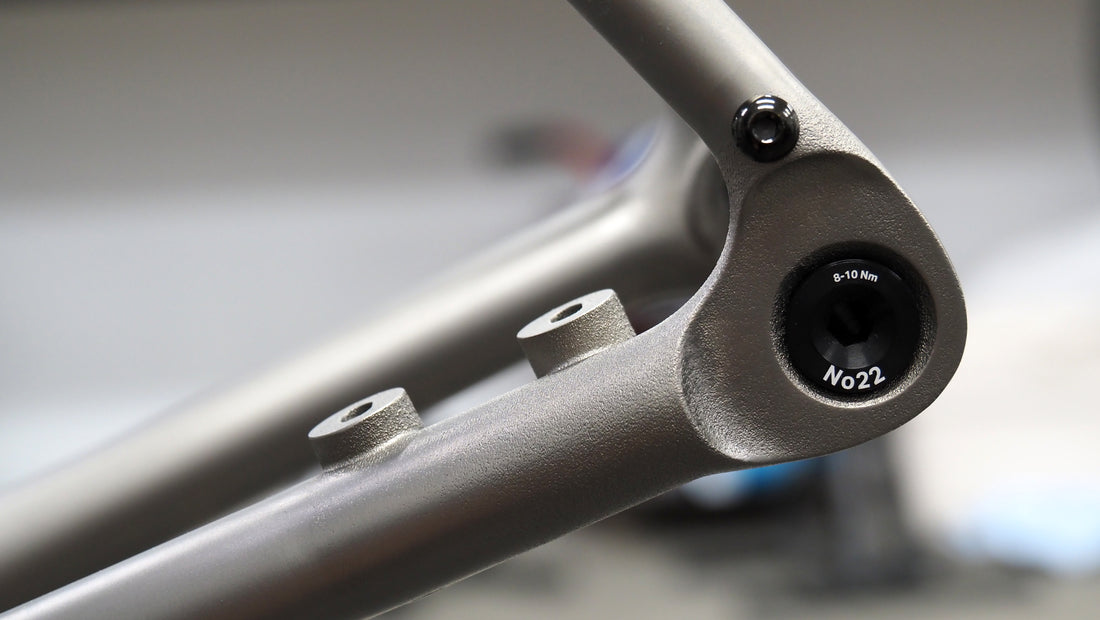
If you asked any framebuilder what is the part that most drives the construction of a frame, chances are they'll tell you it's the dropout. The dropout is responsible for more design and construction decisions than any other part of a frame, and plays a key role in the frame's structure, alignment, serviceability, durability and looks.
Against that backdrop we began the process of revising our disc brake dropouts nearly three years ago, and after several years of iterating, prototyping, testing, and revising we are pleased to be rolling out the latest iteration of our dropouts at last. Designed around 3D printed, sintered titanium construction these dropouts are substantially stronger and lighter than the versions they have replaced, but there are a host of other more subtle (and more interesting) gains these dropouts enable.
Printed for us by Silca in Indianapolis, USA, these dropouts represent the highest performing part we can envision for our frames.

Substantially Stronger at the Same Weight
One of the most touted advantages of 3D printing is the ability to place structure inside formerly hollow or solid parts, and the resulting improvements in strength-to-weight can be enormous. Our newest dropouts take full advantage of this opportunity and incorporate large cross sections throughout for tremendous strength and stiffness compared to CNC or flat plate dropouts. Internal "gyroid" structures (picture wavy lattices of tiny internal supports) have been used in what would otherwise be internal voids, adding even more strength to the part.
The new dropouts also incorporate the flat mount interface for the rear brake caliper, which improves the frame's ability to handle the rear braking loads while also providing a more precise mounting surface for the rear caliper. This stiffer, more precise mount for the rear brake caliper reduces brake rubbing, improves brake alignment and simplifies rear brake setup.
The end result is a part with a tremendous increase in strength at a nearly identical weight as our outgoing dropouts.

Above: our previous CNC machined dropouts and separate posts for flat mount disc brakes (left), compared to the new 3D printed dropouts and integrated brake mount (right).
Improved Fatigue Life through Heat Treating
One of the benefits of working with Indianapolis-based Silca for these new dropouts is their proximity to large aerospace players. 3D printing of titanium has become a staple of new aerospace development, where long-term durability is crucial. Leveraging this knowledge, after printing our dropouts are shipped to a nearby Rolls Royce aerospace contractor for heat treating in their facility using their proprietary process in a full vacuum. The purpose of the heat treating is to remove residual stresses from the material by eliminating brittle grain structures. After heat treating, the part has over 99.5% the density of billet 6-4 Ti. The heat treating process results in an increase in fatigue strength of over 75%, greater resistance to cracking, and lower porosity of the finished part.
By taking this extra step, we end up with the strongest, most durable dropout possible, which should more than live up to the durability expectation of a titanium frame.

Looks and Refinement
With a new construction technique came an opportunity to update and refine the design language of our dropouts. The organic, subtle shaping made possible with 3D printing allowed us to more tightly integrate the design of the dropouts, rear brake mounts, thru axle and derailleur hanger into one fully resolved package. The dropout flows cleanly into the chainstays and seatstays without interruption.
We have incorporated the design of replaceable derailleur hangers for clean looks and ease of service. All dropouts can accommodate fender mounts, and use either a small grub screw or a larger fender bolt depending on the frame's configuration.
Cable routing is another area that we have been able to optimize. All of our new dropouts are printed with an internal channel for clean and easy routing of shift wires. For wireless builds, this channel is permanently covered by printed titanium, while for wired builds the port is opened during the build process for clean, guided cable routing through the dropout.

Process and Fabrication Improvements
With a redesign of our dropouts came an opportunity to more tightly optimize the design of the dropouts for our manufacturing methods. One of the most challenging aspects of flat mount rear disc brakes on metal bikes is the number of welds they require at the dropouts, which can make keeping a frame's alignment within tolerances challenging. Welds introduce tremendous heat and quick cooling to a frame, and that causes the frame to want to distort in response.
By integrating the rear disc brake mount into the printed structure of the dropout, we eliminate multiple welds from every frame's rear end, and the impact on frame alignment is profound. In addition, by designing a specific dropout for each frame size we ensure perfect alignment between the chainstays, dropouts, and seatstays without the need for complex mitering.
Finally, whenever titanium is welded it requires a "purged" environment, where a gas such as argon is run through the frame in order to displace oxygen. The better the purge, the more completely the oxygen can be displaced, and the stronger the resulting weld. In designing the internal structure of our dropouts, we optimized the hidden internal lattice to improve flow of purge gases, resulting in a stronger, more consistent weld on every frame.

Conclusion
While these new dropouts are not the first 3D printed component we are using in regular production, they are so far the most complex and the impact on our bikes is significant. We are rolling these dropouts out to all new orders as part of our ongoing quest to deliver the best constructed, most refined bikes possible.







